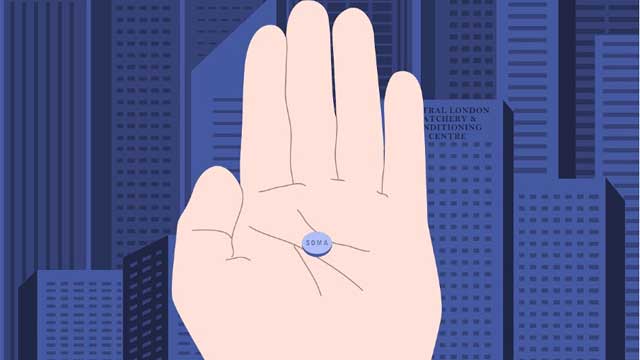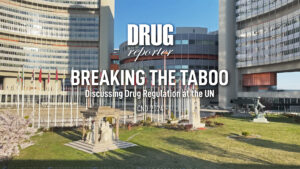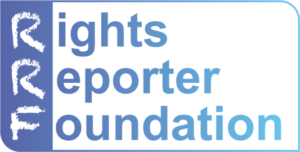In Romania, the urban legends that ‘legal highs’ have inspired, speak of the traumas and hardships faced by injecting drug users.
A long-term heroin user who started to inject synthetic stimulants he bought from ‘spice-shops’ in Bucharest, Romania, Tudor* says he didn’t even care what these new drugs were. People and the media called them ‘legals’, ‘legal drugs’ or ‘ethnobotanicals’. Other homeless ‘junkies’ with whom he used to inject in the city’s sewers just told him the police wouldn’t pick on him if he showed them the receipt he got from the shop, if he was caught with drugs on him. “I even injected in their presence, right there. And the police would say: ‘Come on! Do it already and let’s check you out’,” he recalls. They let him go.
You can download the publication by clicking here.
Not even 30, and HIV-positive, kicked out of his family’s home while still a teenager by an alcoholic and violent father, and mostly living on the streets ever since, he often thought death could not possibly be worse than the life he had. He felt that his family wanted him dead. They tried to make amends by taking him in to sleep on the floor in exchange for some rent money he gave them every month – money that came from his disability pension as an AIDS sufferer – but finally they threw him out on the streets again when they learned he was infected. He felt that the world wanted him dead. Him and others like him. “Because of the very numerous population on the planet they want to reduce the numbers and they’re starting with the drug users,” he tells me when I ask him what he makes of the ‘dream shops’ which sold him the (mephedrone-based) Special Gold and other labels like Energy or Pure by Magic that he replaced, or mixed his heroin with.
A Romanian medic who prescribes methadone and suboxone to opiate users turned ‘legalists’ like Tudor, calls himself a ‘world conspiracy theorist’, and thinks there’s something quite bizarre about the pharmaceutical industry not having developed proper detection methods (like urine tests) for these new psychoactive substances (NPS) that have been around for almost half of decade now in most European countries**. This makes it impossible to prove to a person who is using a drug that he or she might have a problem and this blocks the first phase of any healing process, he adds. Like Tudor, he says that the depopulation of the planet might as well begin with drug users, to serve the ‘masons’’ plan of reducing the global population to a controllable size.
“They’re starting with the drug users”
Various conspiracy theories have accompanied the new ‘golden age’ of innovation that has seen hundreds of drugs being sold across Europe and the Americas via Internet outlets or head-shops. Over 250 NPS were reported by UN member states to the United Nations Office on Drugs and Crime (UNODC) by 2012, surpassing the number of substances regulated by international drug conventions (234). That same year, a EUROPOL-EMCDDA snapshot study identified close to 700 European online shops distributing such legal highs in 20 EU languages, as well as Norwegian, Russian and Ukrainian.
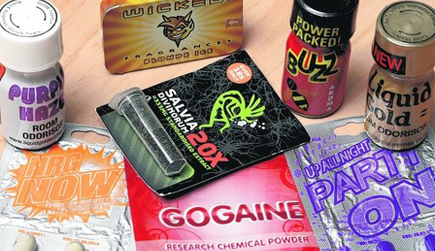 According to the European Monitoring Centre for Drugs and Drug Addiction (EMCDDA), two-thirds of the NPS that reach the continent are synthetic cannabinoids and synthetic cathinones, mostly imported from Asian countries such as China and India by local entrepreneurs aware of the immense potential of new information technologies to attract both experienced and experimental users. The same source notes that even though organised crime structures have been involved in the global NPS trade, the market is largely driven by the former type of business interests. However, the vividly colored windows of dream shops displaying marijuana leaves and psychedelic symbols on the streets of conservative Eastern European countries like Romania, have inspired a new urban folklore.
According to the European Monitoring Centre for Drugs and Drug Addiction (EMCDDA), two-thirds of the NPS that reach the continent are synthetic cannabinoids and synthetic cathinones, mostly imported from Asian countries such as China and India by local entrepreneurs aware of the immense potential of new information technologies to attract both experienced and experimental users. The same source notes that even though organised crime structures have been involved in the global NPS trade, the market is largely driven by the former type of business interests. However, the vividly colored windows of dream shops displaying marijuana leaves and psychedelic symbols on the streets of conservative Eastern European countries like Romania, have inspired a new urban folklore.
“You can’t tell me there’s a trafficker behind this, because nothing enters this country without them allowing it to enter,” Emil accuses. The ‘them’ he refers to, are Parliament and Government officials, who get ‘the lion’s share’ from the new drug trade, and the “only president who allowed legal drugs to be sold in his country”. Like Tudor, he had been shooting heroin for more than a decade when he tried the first generation of amphetamine-type stimulants (ATS) distributed by local head-shops. He liked the first wave, but by the time these drugs were banned and the next labels settled in – Romania placed 44 NPS under control in February and June 2010 – he was permanently brain damaged, he claims. Bad trips on drugs like Pure by Magic, and other powders sold as bath salts or plant fertilisers, brought him bizarre hallucinations and paranoid thoughts: Seeing his mother being shot by burglars in front of his eyes, in his family’s living room, hiding from imaginary snipers camouflaged in the trees around his house, and having hidden cameras planted in his closets, were just some of them.
Like many other injecting NPS users in the country, Emil thinks Romania’s presidential family was behind the booming business. The legend took shape just as Elena Băsescu, daughter of acting President Traian Băsescu, and an aspiring young politician herself, declared that she would consider supporting the legalisation of light drugs as part of her 2009 campaign for a seat in the European Parliament – which she finally managed to obtain. The political opposition at the time also spoke of a businessman in the president’s entourage being involved in the massive distribution of the new drugs in the country. Dorin Cocoș, former husband of Elena Udrea, tourism minister and a key politician in Băsescu’s Liberal Democratic Party at the time dream shops were starting to make serious profits, was thus said to have financed the party’s electoral campaigns by pumping drug money into its bank accounts. One legend that injecting drug users (IDUs) in Bucharest will tell you, is that Cocoș and Udrea first tested Pure and other NPS in hospitals, on heroin addicts, and only mass-marketed them when they noticed that they relieved users of opiate withdrawal sickness, to make sure they would sell fast. Rumours also surrounded the dismantling of the National Anti-Drugs Agency as an agency of the Ministry of Internal Affairs and drug policy coordinating body, and its transformation into an obscure department of the General Inspectorate of the Romanian Police, in 2009, just as spice shops were starting to bloom in the big cities.
NPS thrive, NSP struggling to survive
Some users started injecting NPS not only because it would keep the police away, but also because they wished to be ‘normal’. If NPS were legal, it meant they had been assessed by the country’s health authorities, they thought. If they were ‘ethnobotanicals’, it meant they were natural and safe to use. If they were safe to use, it meant they could be used as treatment for their heroin habit. Alina, an IDU in her early twenties, asked her parents for money to buy sachets that “only contained vitamins, magnesium or calcium”, according to the packaging: “Look, mom, I’m quitting heroin just by taking vitamins!” A lot of her ‘junkie’ friends genuinely thought the new substances would be antidotes for the nausea or pains that came with the ever less pure and harder-to-find ‘misery drug’, as they called it. At first, they didn’t seem to worry about bingeing for sleepless days and nights on the stimulants, or about injecting considerably more frequently – up to 10-15 times a day.
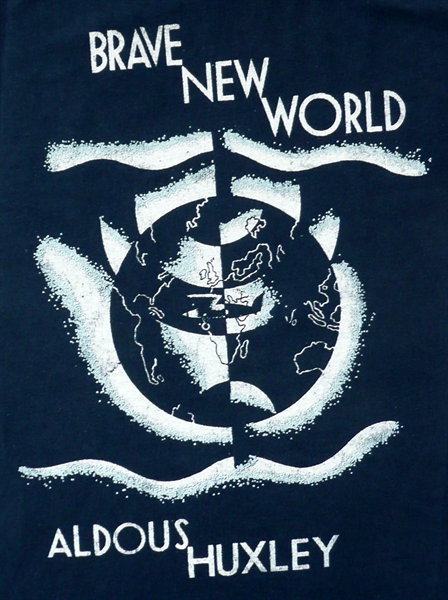 By the end of 2012, over half (51 per cent) of the clients of the needle and syringe programs (NSP) in Bucharest were only using NPS, and another five per cent were doing both synthetic stimulants and heroin. Where, up till 2008, around one in every hundred Romanian IDUs tested positive for HIV, five years later the ratio rose to one in four. This trend was related to the increased frequency of injection, and the reckless shooting behaviour usually accompanying NPS, at a time when harm-reduction services in the country were being scaled down as a result of losing international funding: From 2009 to 2011, the number of clean syringes they distributed each year dropped by 800,000.
By the end of 2012, over half (51 per cent) of the clients of the needle and syringe programs (NSP) in Bucharest were only using NPS, and another five per cent were doing both synthetic stimulants and heroin. Where, up till 2008, around one in every hundred Romanian IDUs tested positive for HIV, five years later the ratio rose to one in four. This trend was related to the increased frequency of injection, and the reckless shooting behaviour usually accompanying NPS, at a time when harm-reduction services in the country were being scaled down as a result of losing international funding: From 2009 to 2011, the number of clean syringes they distributed each year dropped by 800,000.
According to a recent EDPI report on NPS, limited access to treatment programs was one of the factors that encouraged Eastern European IDUs, in countries like Romania and Hungary, to migrate en masse to the new drugs, when local markets were also experiencing severe heroin shortages. One other peculiarity of these markets was the general fear of criminal prosecution among IDUs, who mostly came from the disenfranchised sections of society, and who naturally wanted to stay away from trouble. The same study referred to severe psychiatric disorders and (rare) fatalities resulting from injecting NPS use, even though the numbers remain in dispute. Effective substance-detection technologies, to keep up with the rapid pace of the highly innovative new drug markets, have still not been established. Up until late 2011, forensic data still showed heroin and more traditional legal substances like benzodiazepines or barbiturates to be responsible for most fatal overdoses.
This absence of medical information about NPS was again interpreted in the streets as a conspiracy of silence. “It starts at the top. That’s why they don’t say how many die or if anyone dies from legals at all. I think that during these years at least 500 people died,” one NPS user told me. Another one thought that saving some of the money spent on treating heroin users was the very point of their systematic annihilation. Victor remembers meeting “a man with gray hair and a fancy briefcase” on the street, who was kind enough to give him his spare change, and who told him he would happily kill all those selling ‘junkies’ their ‘legals’. “They had kids dying themselves, they saw it on TV, they feel sorry for us,” Victor adds.
Killing them softly with soma?
The myth of the ‘smart guys’ in high political offices draining the cash and the life out of the drugged poor continued to fill thhe popular imagination, even after new NPS legislation paved the way for a more efficient clampdown on head shops. Almost 670 control activities were carried out in 2012, with more than 38,000 sachets of NPS being confiscated and well over 200 persons being put under investigation. Where official data showed close to 160 spice shops operating in the country in March 2011, by the end of 2012 only one active shop could be identified. One shop in Ferentari (one of Bucharest’s poorest and most drug-affected neighbourhoods) that managed to keep its doors open, was said to be secretly owned by a high-ranking official within the City Police. Many users living in the area shared this story with me, including one who added that the owner only brought in the stocks himself. He purportedly did it only at night, without ever staying on site more than five minutes, and he drove an expensive car. “I don’t know what his fucking rank is, but they’re always complaining about what shitty salaries they get. How could he afford a (Audi) Q7?” he says.
No mammoth drug-trafficking structure operating in the country leading to the tip of the political iceberg was ever identified, apart from the opportunist networks that still continued to sell the substances which the government scheduled in 2010, in the midst of the media-led NPS panic. Still, the doctor who prescribes methadone to intravenous users says that 5 billion people on the planet are too many for the masons who rule the planet, and that 500 million is the ideal level. He also believes they’re breeding brainless individuals who can easily be controlled through ‘soma’-like narcotics***. Emil would agree with him, as he confesses that he feels irreversibly scarred by his years of injecting NPS. Even when he stays away from them, he still has nightmares of strangers breaking into his house and stabbing him in his sleep. The director of a local NGO that runs drug education programs whom I interviewed, would tell him that he was just an unfortunate guinea-pig in a field-test leading up to the introduction of more liberal drug policies by the UN, targeting countries with particular population-size and culture – a test-program aimed at assessing the impact of a possible massive legalisation of all drugs.
These legends and stories might seem amusing, as much as tragic. The urban folklore that dream shops left behind might hide a grain of truth, just as easily as it might be just the residual image of a market which makes its profits, whatever the human cost, by exploiting the breaches of prohibitionist global policies which by criminalising drugs, turn them into highly-priced commodities. What all these tales of systematic extermination and abandonment do say beyond any doubt, is that in the war on drugs, those who are symbolically abandoned and systematically killed, are always the drug users.
Liviu Alexandrescu
(The author is a freelance journalist and a PhD student in sociology at Lancaster University, UK. He is currently also involved in research on legal highs.)
——
* All the names that appear in this article have been made up to protect the persons behind them.
** This article is based on ethnographic data mostly collected between April-September 2012.
*** The ideal pleasure drug used for social control purposes imagined by Aldous Huxley in his 1932 novel Brave New World.
